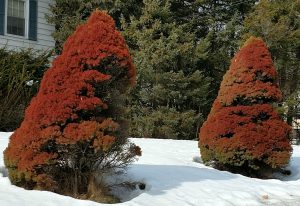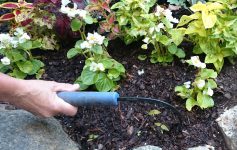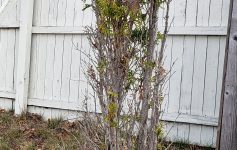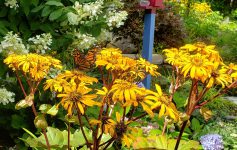 Taking a walk around your gardens during this week’s warmer temps you may notice some disturbing changes in your shrubs. Winter weather challenges our woody plants in many ways. Even if you are vigilant in selecting plants hardy to our region, variable weather conditions can create problems that begin to show winter garden challenges late January/February. You may be noticing a brown discoloration in your conifers and broadleaf shrubs. (those that keep their greenery all winter) These plants slow down their growth during the winter, but never really go fully dormant. Dry winds and winter sun often burn out conifer needles and broadleaf evergreen foliage. This is particularly evident in the Alberta Spruce. You will often see the south side of the Alberta browned out. This is due to the small thin size of the needles and the position of the sun. The frozen soil cant uptake water to minimize this. Roadside salt spray is another huge contributor to needle brown out especially in the white pines. Although heavy snow can damage branches, it does add a level of moisture and protective insulation to the root bases. This year we have had a good amount of snow cover. Freeze/thaw cycles can typically force root balls out of the ground. February is often the month we begin to experience a winter thaw. Without snow coverage this can cause roots to dry out. And of course there is the hungry wildlife struggling to find food when the ground is snow covered. Deer especially will gnaw on anything they can get their hands on…namely your precious shrubs.
Taking a walk around your gardens during this week’s warmer temps you may notice some disturbing changes in your shrubs. Winter weather challenges our woody plants in many ways. Even if you are vigilant in selecting plants hardy to our region, variable weather conditions can create problems that begin to show winter garden challenges late January/February. You may be noticing a brown discoloration in your conifers and broadleaf shrubs. (those that keep their greenery all winter) These plants slow down their growth during the winter, but never really go fully dormant. Dry winds and winter sun often burn out conifer needles and broadleaf evergreen foliage. This is particularly evident in the Alberta Spruce. You will often see the south side of the Alberta browned out. This is due to the small thin size of the needles and the position of the sun. The frozen soil cant uptake water to minimize this. Roadside salt spray is another huge contributor to needle brown out especially in the white pines. Although heavy snow can damage branches, it does add a level of moisture and protective insulation to the root bases. This year we have had a good amount of snow cover. Freeze/thaw cycles can typically force root balls out of the ground. February is often the month we begin to experience a winter thaw. Without snow coverage this can cause roots to dry out. And of course there is the hungry wildlife struggling to find food when the ground is snow covered. Deer especially will gnaw on anything they can get their hands on…namely your precious shrubs.
Our deciduous trees and shrubs, those that lose their leaves in the Fall, have adapted to our cold winter climate by going into dormancy before the coldest of our weather arrives and remains dormant until the spring. Generally, mature, well established deciduous trees and shrubs will survive our tough winters. However, newly planted varieties will need extra care to get through our tough North Country winters.
As you begin to plan for your new garden season, here are a few tips to minimize winter garden challenges:
In General (especially for newly planted Shrubs and Tree):
- Keep watering your plants until the ground freezes. Many gardeners rely upon automated sprinkler systems for their watering. Often times the installers will shut down systems in September. We recommend you keep those systems up and running until the end of October in our region…or plan to hand water so it reaches deep into the root zone a good 12-18 inches
- DO NOT prune your trees and shrubs after mid summer. This is especially important for our region as we may experience frosts in early October. Pruning tends to stimulate new growth and delays dormancy.
- Stop fertilizing plants 6 weeks before the first frost. This will allow your plants to harden off properly. I use http://thefarmerslamanac.com for predictions of when to expect first frost. Enter your zip code.
- Always make sure your plant bases have a 3 inch layer of organic mulch. This practice not only retains the moisture roots need for the winter, but adds a level of insulation, reducing root ball heaving. A good snow cover will provide weight to assist in the decomposition of the organic material and give a natural feed early spring.
- When selecting your plant material it is not often enough to look at cold hardiness. Your particular setting will have micro-climates and wide variations of temperature based on elevation, soil type, urban island heat effect, etc. My gardens here in Greenfield are usually a good 3-5 degrees colder than Saratoga Springs.
For Conifers and Broadleaf Evergreens:
- In highly exposed windy areas, I cover my broadleaf shrubs with burlap. I have done so at the National Museum of Dance for the past 3 years, and had great success reducing browning of leaves, winter dieback and foraging deer.
- I highly recommend shrub covers for foundation plantings, especially if you have a metal roof. The weight of heavy snow fall and ice will be minimized with the covers. You will have to adjust your height as the shrub grows, but well worth your time and investment.
- If you are a roadside property who experiences a good deal of plow and salt spray, check with your gardening professional on varieties of woody plants that are salt-tolerant
- after an ice storm DO NOT try to remove the ice from branches. You will do more damage than good. Removing the heavy loose snow however is recommended.
- Although brown out needles are evident, don’t be anxious to prune in early spring. Many will bounce back with new bud growth. Just deal with ugly a bit.
- In the case of Rhododendron, I adopt a wait and see on these too. Obvious loose fully browned out leaves will fall with your touch. But don’t go pruning until after bloom and you see the new growth tips
- Arbor Vitae are not my evergreen of choice in our region due to deer desire for this tasty treat. But when I have to deal with them on a property, I do apply deer netting or other protective measures to keep them safe from winter foraging.
As you enter your new garden season, do a winter damage assessment now and early spring. Then use some of these tips throughout the season to minimize winter damage in 2019. As always keeping common sense and sustainability a part of my garden practices.
Are you getting ready for your garden season “dirt manicure”? Then join me at the Beautiful Longfellows Conference Center in Saratoga Springs, Saturday April 28th. I will be hosting a fun and informative Dig into Gardening Day, featuring local garden professionals, all with a focus on common sense and sustainable practices. We will also be treated to a garden focused culinary demonstration by Longfellow chef and healthy luncheon. For more information visit my website: http://gardengoddesssenseandsustainabilty.com



